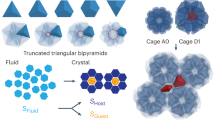Abstract
The model of a clathrate solid solution, taking into account directed and nondirected guest-guest interactions, has been obtained using statistical thermodynamic methods in the approximation of the mean-field type for the general case (the formation of cavities of several types and the inclusion of different kinds of guest molecules by the host). Consideration of this interaction has been shown to improve the quantitative agreement between theory and experiment. When the guest-guest interaction is considerable in the case of guest molecules of the same type a phase transition (of a gas-liquid type) of the guest component may occur in the clathrate matrix. In the case of guests of two different types, the phase transition of the guest subsystem of the liquid-liquid type may also occur within one framework at the expense of a preferable interaction among guest molecules of the same type.
We present the isothermal (20°C) section of the phase diagram of a hydroquinone-— formic acid — acetonitrile system. Clathrates, forming in the binary systems (with hydroquinone) produce restricted solid solutions (of type IV, according to Roozeboom). These and other experimental data are discussed in terms of the proposed theory.
Similar content being viewed by others
References
D. E. Palin and H. M. Powell:J. Chem. Soc. 208–221 (1947).
H. M. Powell:J. Chem. Soc. 61–65 (1948).
H. M. Powell: Clathrate Compounds, inNon-Stoichiometric Compounds (Ed.: L. Mandelcorn) (Russian Translation), pp. 398–449, Khimiya, Moscow (1971).
J. H. van der Waals:Trans. Faraday Soc. 52, 184–193 (1956).
J. H. van der Waals and J. C. Platteeuw:Adv. Chem. Phys. 2, 1–57 (1959).
V. R. Belosludov, Yu. A. Dyadin, O. A. Drachiova, and G. N. Chekhova.Izv. Sib. Otd. Akad. Nauk SSSR Ser. Khim. Nauk 9, 60–67 (1979);C.A. 91, 163770u (1979).
V. R. Belosludov, Yu. A. Dyadin, and S. I. Fadeev:Izv. Sib. Otd. Akad. Nauk. SSSR, Ser. Khim. Nauk 7, 57–63 (1981);C.A. 95, 103481y (1981).
G. N. Chekhova and Yu. A. Dyadin:Izv. Sib. Otd. Akad. Nauk SSSR, Ser. Kim. Nauk 12, 75–82 (1978);C.A. 89, 221769x (1979).
G. N. Chekhova and Yu. A. Dyadin:Pol. J. Chem. 56, 407–410 (1982).
P. Sixon and P. Dansas.Ber. Bunsenges. Phys. Chem. 80, 364–389 (1976).
S. R. Gough, S. K. Garg, and D. W. Davidson:J. Chem. Phys. 3, 239 (1974).
T. Matsuo, H. Suga, and S. Seki:J. Phys. Soc. Jpn. 30, 785–793 (1970).
M. Sitarski:Rocz. Chem. 49, 159–164 (1975).
V. R. Belosludov, Yu. A. Dyadin, G. N. Chekhova, and S. I. Fadeev:J. Incl. Phenom. 1, 251–262 (1984).
D. E. Evans and R. E. Richards.Proc. R. Soc. London 223A, 238–250 (1954).
F. A. Schreinemakers:Z. Phys. Chem. 11, 75–100 (1893);55, 71–98 (1906).
L. D. Landau and E. M. Lifshits:Statisticheskaya Fizika, 113, Nauka, Moscow (1964).
V. E. Schneider, E. E. Tornau, and A. A. Vlasova:Chem. Phys. Lett. 93, 188–192 (1982).
A. A. Vlasova and V. E. Schneider:Litovskii Phys. J. 23, 14, 61–72 (1983).
R. Braut:Phase Transitions (Russian translation), p. 26, Mir, Moscow (1967).
A. W. Adamson:Physical Chemistry of Surfaces, 3th edn. (Russian translation), pp. 446–447, Mir, Moscow (1979).
C. Kittel:Introduction to Solid State Physics, 4th edn. (Russian translation), p. 117, Nauka, Moscow (1978).
Yu. N. Kazankin, A. A. Palladiev, and A. M. Trofimov:Zh., Obshch. Khim 42, 2607–2611, 2611–2615 (1972);C.A. 78, 76317g, 76316g (1973).
D. E. Palin and H. M. Powell:J. Chem. Soc. 815–821 (1948).
S. V. Lindeman, V. E. Shklover, and Yu. T. Struchkov:Cryst. Struct. Commun. 1173–1179 (1981).
T. L. Chan and T. C. W. Mak:J. Chem. Soc., Perkin Trans. 2, 773 (1983).
Yu. A. Dyadin, and L. S. Aladko:Zh. Strukt. Khim. 18, 51–57 (1977);C.A. 87, 12297m (1977).
S. C. Wallwork and H. M. Powell:J. Chem. Soc., Perkin Trans. 2, 641–646 (1980).
T. M. Polyanskaya, V. I. Andrianov, V. I. Alekseev, V. V. Bakakin, Yu. A. Dyadin, and G. N. Chekhova:Dokl. Akad. Nauk SSSR 226, 349–353 (1982).
H. C. McAdie and C. B. Frost:Can. J. Chem. 36, 635–651 (1958).
Yu. A. Dyadin, G. N. Chekhova, and I. I. Yakovlev:Izv. Sib. Otd. Nauk SSSR, Ser. Khim. Nauk 15, 49–55 (1973),C.A. 80, 64395s (1974).
Author information
Authors and Affiliations
Additional information
Dedicated to Professor H. M. Powell.
Rights and permissions
About this article
Cite this article
Belosludov, V.R., Dyadin, Y.A., Chekhova, G.N. et al. Hydroquinone clathrates and the theory of clathrate formation. Journal of Inclusion Phenomena 3, 243–260 (1985). https://doi.org/10.1007/BF00655728
Received:
Issue Date:
DOI: https://doi.org/10.1007/BF00655728



